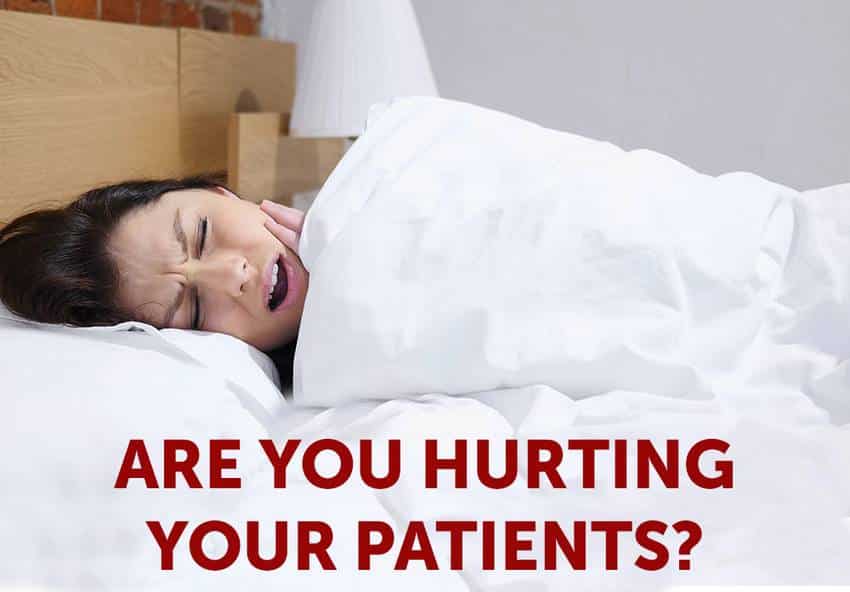
Lip Filler vs. Lip Flip: Which Is Right for You?
By Brigid Landrum, RN When it comes to enhancing your smile, the world of cosmetic procedures offers a variety of options to achieve your desired look. Two popular treatments

By Louis Malcmacher, DDS, MAGD, DAAFE Monday, June 02, 2014 2:45 PM
When was the last time you made the patient a bruxism appliance? If you are like most dentists, you make bruxism appliances for patients all the time. Many clinicians have their favorite bruxism appliance that they use in most or all cases. You may like to use an anterior plane appliance, some dentists swear by full arch coverage so they don’t get any orthodontic intrusion or extrusion, and some of you like only posterior coverage since you don’t want to put any stress on the anterior teeth. We give our favorite bruxism appliance to patients in the hope (and prayer) that they will get better. Let’s be honest, many times when they get better, it is more luck than skill. If they don’t get better, we adjust and re-adjust the appliance until such time that either the patient or we give up by telling the patient that the appliance will not solve their problems.
Most dentists also never consider what other consequences the patient may have when wearing a bruxism appliance. Do you know that every time you place an appliance in the mouth, it has an effect on much more than you probably realize. That appliance will affect the TM joint and all of the masticatory and head and neck muscles. Even more importantly, everything you put in the mouth will affect the patient’s airway in either a positive or negative way. This may come as a big surprise to dentists but it is really just common sense.
It has been my experience in lecturing to thousands of dentists every year that most dentists do not realize that the patient’s airway should be their concern. After all, we are just trying to control the patient’s bruxism by making a “bruxism appliance” and are therefore not responsible for the patient’s airway. That would pretty much like saying that when we place crown on the upper molars that we are not responsible for the lower molars – of course you are, it is all interconnected and our responsibility.
This connection is the primary reason that dentists need to be trained in the areas of bruxism therapy and dental sleep medicine together before they make another “bruxism” appliance. Obstructive sleep apnea is a medical condition that affects approximately 40 million people in the US of which 90% is undiagnosed. Simply put, obstructive sleep apnea (OSA) is a condition where the patient stops breathing at night for periods of 10 seconds or more because of an anatomical obstruction of the airway. This can happen tens or hundreds of times a night. OSA is co-morbid and dramatically increases the incidence and severity of diabetes, hypertension, stroke and heart attacks in patients (and let’s not forget that dentists are patients too).
Bruxism is the mechanism the body uses to advance the mandible forward to open the airway so the patient can breathe. The evidence is clear that sleep bruxism is much more often the result of an airway issue than it is an occlusal issue. Now imagine that you make the patient a “bruxism” appliance and the patient has obstructive sleep apnea. The appliance may be pushing the patient’s mandible backwards thereby closing their airway even more. You have now just made their obstructive sleep apnea worse (effectively choking your patients) and at the same time increased their sleep bruxism.
Dentists also should routinely be testing their patients for both bruxism and obstructive sleep apnea or at the very least, before they make any patient another appliance. This is now possible with a cost effective home bruxism and sleep monitor that can quantify the patient’s Bruxism Episodes Index (BEI) and Apnea-Hypopnea Index (AHI) which scores how many episodes of bruxism and apneas the patient has for every sleep hour. In this way, we can have objective evidence and the data necessary to see how often and at what intensity the bruxism really is. We can also see if the bruxism is related to OSA or if it is primary bruxism. That information is essential and now considered medically necessary before you put anything into the patient’s mouth which can affect their airway.
Training is essential in the areas of orofacial pain, dental and facial esthetics, dental sleep medicine, and oral appliances for bruxism therapy before a dentist ever makes another “bruxism” appliance again. You can get trained online on dental sleep medicine, bruxism therapy and medical insurance billing immediately by going to Education.FacialEsthetics.Org. Many “bruxism” appliances that are currently being made may negatively impact a patient’s health if you do not understand the impact these appliances have on the TMJ, orofacial pain, and OSA. Successful restorative, bruxism, and orofacial pain treatment has now entered a new era with the use of cost effective qualitative testing, BOTOX®, and the relationship of oral appliances and OSA. Dentists can also get paid by the patient’s medical insurance for many of these treatments. It is time for dentistry to catch up with medicine in the ability to objectively measure and use data to help us diagnose and more effectively treatment plan our patients for the best therapeutic pain and restorative outcome.

By Brigid Landrum, RN When it comes to enhancing your smile, the world of cosmetic procedures offers a variety of options to achieve your desired look. Two popular treatments

By Crystal Wilson , NP In recent years, the aesthetic industry has witnessed a remarkable shift towards more natural, less invasive treatments. Among the most exciting advancements in this

By Kaitlyn Konsur , RN In recent years, the popularity of dermal fillers has increased, promising satisfying results for fine lines, wrinkles, and facial volume loss. With minimal downtime